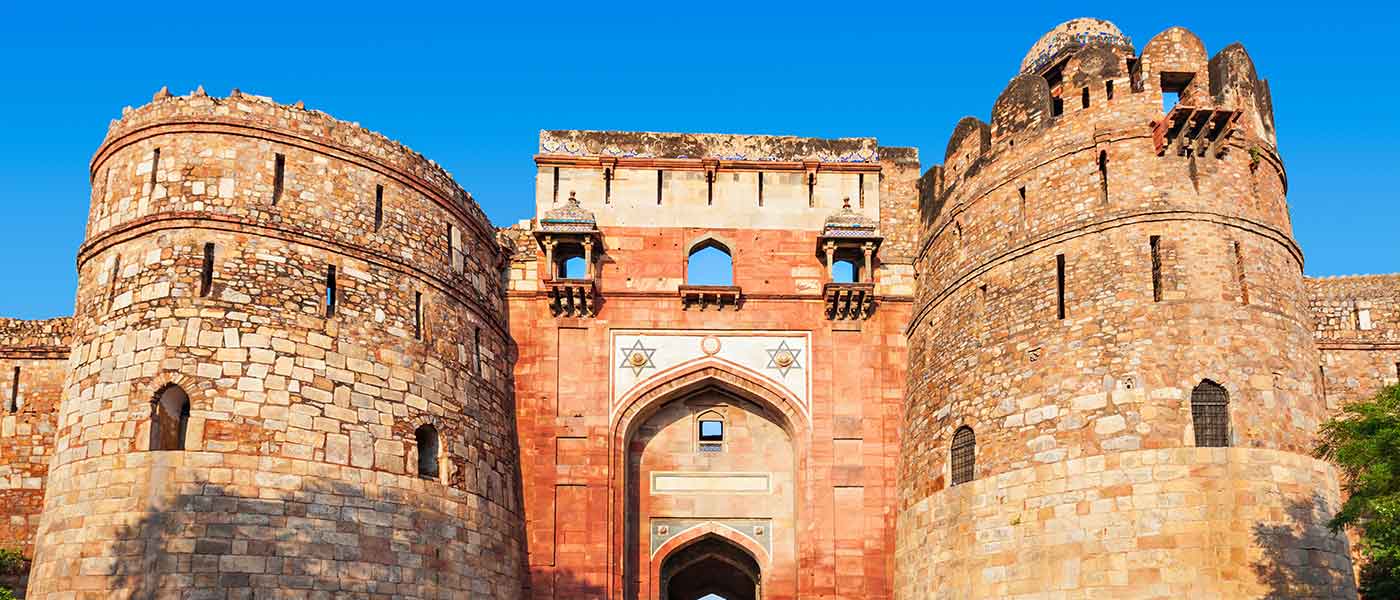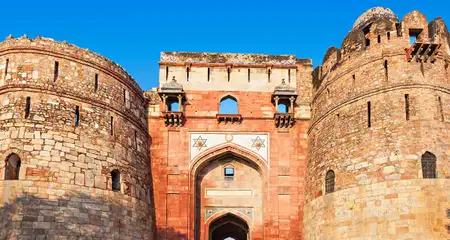Purana Qila aka the Old Fort in Delhi is a fine example of history, heritage, and old-world charm – all of which come together to make it a one-of-its-kind attraction. As one of the oldest forts in Delhi, this Mughal-age edifice has remained witness to Delhi’s eventful history. Whether you are a history buff or not, you will find a lot inside this fort to keep you fascinated. Are you interested in exploring the glorious past of India’s national capital? Then make sure to visit this historical fort when you step out of your hotels in Delhi for a sightseeing tour.
Here’s a blog to help you out. We have compiled all the interesting details about this fort, including its history, architecture, timings, entry fee, and lesser-known facts, to make your visit a pleasant affair.
Purana Qila Information:
| Location | Mehrauli |
| Status | UNESCO World Heritage Site |
| Timings | 7:00 am to 5:00 pm; every day |
| Entry Fee | ₹ 30 for Indians; ₹ 500 for foreigners; free for children below 15 years |
| Still Camera | ₹ 25 (non-commercial use) |
| Video Camera | ₹ 25 (non-commercial use) |
| Nearest Metro Station | Qutab Minar |
| Year of Establishment | 1192 |
| Commissioned by | Qutb-ud-din Aibak |
| Dimensions | 73 meters (height); 14.3 meters (base diameter); 2.7 meters (top diameter) |
| Architectural Style | Indo Islamic Afghan architecture |
| Material Used | Red |
Purana Qila: History
It is widely believed that Emperor Humayun had built this fort and adorned it with colossal gateways back in the early part of the 16th-century. Further, he laid the foundation for his new capital Din Panah at this location. When Sher Shah Suri took control of the structure after defeating Humayun in 1540, he renamed it as Shergarh. During his rule of five years, he made quite a few structural additions to the fort complex.
Over the years, the fort has been the location of many temporary settlements. At the time of the Second World War, this fort served as a camp to around 3000 Japanese people. After the country’s independence and partition, the fort provided shelter to several thousands of people crossing over to Pakistan from Delhi.
Purana Qila (Old Fort) Architecture
Purana Qila is a massive structure with walls rising up to a height of up to 18 meters. They cover 1.5 km in length. Shaped in a rectangular pattern, the fort is adorned with three arched entrances namely the Bara Darwaza (Big Gate), the Humayun Darwaza (South Gate), and the Talaqi Darwaza (Forbidden Gate). All three gates bear a similar feature – that is, they are double-storied structures built in sandstone and adorned with two gigantic semi-circular towers. The ornate detailing on the pavilions (chhatris) and balconies (jharokhas) of the fort gateways display traces of Rajasthani style. The Qila-i-Kunha Mosque situated within the fort exhibits five doorways and is designed in the Indo-Islamic architectural style.
Purana Qila: Today
Today, Purana Qila has lost much of its original grandeur. Though the exterior of the fort still exudes a grand look, many of the internal structures have lost out to the trails of time, nature, and man. Only a few of the internal structures have managed to remain intact. But that hasn’t deemed the popularity of the fort in any way. The fort still remains a big draw among the most popular tourist places in Delhi. The light and sound show held here in the evenings is also a major draw for visitors.
Things to See in the Purana Qila Complex
The Purana Qila fort complex has several attractions that make for an interesting visit. These include:
- Qila-i-Kuna Mosque, a single-domed mosque built by Sher Shah Suri
- Sher Mandal, an octagonal double-storied tower that served as Humayun’s personal library and observatory
- Purana Qila Museum
- The three magnificent entrance gateways
- Kairul Manzil, a mosque constructed by Akbar’s foster mother (outlying monument, about 550 m)
- Sher Shah Suri Gate or Lal Darpwaza, the southern entrance to Shergarh (outlying monument, about 350 m)
Purana Qila Light and Sound Show
Every evening, Purana Qila comes alive with a fascinating light and sound show. Considered to be among the best light and sound shows in India, this show is a visual spectacle that lets you learn a thing or two about the history, heritage, war, politics, and other aspects of Delhi, right from the Mughal period to the modern times. The show is rightly named Ishq-e-Dilli, which means Romancing Delhi.
- Duration: 60 mins
- Timings:
Hindi – 7:30 pm to 8.30 pm
English – 9.00 pm to 10.00 pm
No shows on Fridays - Tickets: ₹ 100 for adults; ₹ 50 for students, senior citizens, differently abled people, and children (3 to 12 years)
Purana Qila Museum
Located next to the main entrance of the fort, Purana Qila Museum is a key attraction in the complex. The major exhibits of the museum include prehistoric tools dating back to the Mauryan, Gupta Sunga, Kushana, and Sultanate periods and several other objects recovered during archeological excavations. Remnants from the First War of Independence and several age-old manuscripts, textiles, pottery, etc. displayed here make it one of the must-visit museums in Delhi.
- Timings: 9:00 am to 5:00 pm; closed on Fridays and public holidays
- Entry Fee: Free
Lesser Known Facts about Old Fort
- It was at Sher Mandal, the library located within the fort, that Humayun had slipped from stairs and met his death.
- Initially, Humayun was buried inside Purana Qila before his body was taken to Kalanaur in Punjab and finally laid to rest at the magnificent Humayun’s Tomb.
- The ramparts of the fort were used as a theatre backdrop in the 1970s when three plays were staged by the National School of Drama.
- Recent excavations have led to the theory that the fort was built on the same site where the Pandava kingdom of Indraprastha once existed.
Attractions near Purana Qila
- National Zoological Park (550 km)
- India Gate (2.1 km)
- Humayun’s Tomb (2.9 km)
- Nizamuddin’s Tomb (2.9 km)
- Mirza Ghalib’s tomb (2.7 km)
- Parliament House (4.4 km)
- Rashtrapati Bhavan (4.6 km)
- Jantar Mantar (5 km)
Purana Qila in Delhi is a living piece of heritage that gives you a glimpse into the city’s rich past. How about soaking in the historic beauty of this grand old fort?

























 Avg. Budget, How to Reach
Avg. Budget, How to Reach


